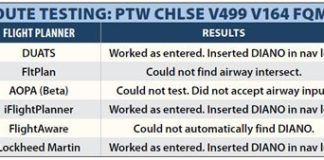Someone asked me about a note on the ILS Z or LOC Z Rwy 23 at Walterboro, SC (KRBW). The note says: “GPS and DME required.” (Emphasis added.) How can that be? GPS can be used in lieu of DME, but it can’t be a typo because it would just say “DME required.”
The note is correct as written—and an IFR GPS alone is fine. Now follow me down a logical rabbit hole to understand why, as well as see how GPS and digital tech in general are changing how we fly IFR.
You may also discover something you’ve misinterpreted about approach charts for years.
Charting Efficiency Long Ago
The key to unlocking this mystery is the chart title: ILS Z or LOC Z Rwy 23. Letters from the tail end of the alphabet (X, Y, and Z) differentiate multiple approaches to same runway. Don’t confuse this with titles that contain letters from the beginning of the alphabet, such as a VOR-A that have no runway name and only circling minimums.
Often, the Z offers lower mins requiring a higher climb gradient on the missed. The Y and Z versions of the ILS to Rutland, VT, for example, differ in DA by 600 feet, however that lower DA requires 370 feet per NM on the missed.
Different equipment requirements also yield X, Y, and Z versions; that’s the case at KRBW. The Y approach is a pretty conventional ILS with a requirement for DME in the notes. Why DME?
Equipment requirements for an en route transition appear on the plan view, not in the notes. The IAF at LAMKE is a fix on V18-311, so you can get there using airways. By policy, no ILS requires DME to identify the FAF or DA. The missed approach is a heading to intercept R-282 off the CHS VOR and goes to STOAS—an intersection with R-209 from the VAN VOR. No DME required there.
In fact, DME isn’t required for the ILS at all. DME is only required for the localizer approach to identify the FAF at DOTMY, or the MAP at 1.1 DME. Note that there’s no timing published.
You can fly the ILS Y Rwy 23 with basic nav/comms. DME (or GPS) is only required if you fly the LOC Y Rwy 23.
Two-For-One Special
Before you send that email expounding that notes aren’t optional, look at the title again. It’s “ILS Y or LOC Y,” not “ILS-or-LOC Y.” This isn’t a single approach with an optional glideslope. This chart displays two distinct approaches on a single document.
The ILS is a different approach with different obstacle requirements and procedures than the localizer approach. They even have different database codes. Anyone who remembers a stuffed case of paper charts knows why. Most ILSes had an accompanying localizer approach that looked mostly the same, so they were co-charted to keep chart binders and cases a bit less hernia-inducing.
This duality reveals itself in your chats with ATC. Ask for the ILS or the localizer and you get that specific approach. Switch from one to the other if the glideslope fails, and technically you need a new clearance. No one cares in practice (nor should they, in my opinion). However, that’s another discussion.
So, it’s “ILS Y or LOC Y Rwy 23,” not “ILS or LOC Y Rwy 23.” And before I get the email saying your local approach says, “ILS or LOC Y…” note that this confusion goes right up to Oke City. The charting office even had to straighten themselves out. Expect KRBW-style naming as charts are updated.
Now check out the ILS Z or LOC Z Rwy 23. GPS lets you transition from the en route environment with no-PT sectors allowing direct LAMKE. But you could still arrive via airway, without GPS. Like the Y approach chart, DME is required only for the localizer version and you may substitute GPS.
The Z approach has a different missed—GPS-direct to STOAS rather than intercepting a radial east of STOAS and then proceeding outbound. This requires GPS, and applies to both the ILS and the localizer approaches.
Put all this together and “GPS and DME required” should actually be “GPS required for ILS Z or LOC Z missed approach procedure. DME (or GPS in lieu of DME) required for LOC Z approach.”
Requirements Clarified
Wouldn’t it be easier if the FAA just stated equipment requirements in plain English? They will—a new area in the briefing strip will specify what’s required for what. I don’t have the details, but I’ll be happy to see it put into effect.
This all begs the question: Why bother telling you DME is required when GPS is required and that would cover your need for DME?
Well, imagine the Y version didn’t exist and you were in an old /U airplane. This ILS Z or LOC Z Rwy 23 is your only available approach, but you still need GPS for the missed. If you could eliminate that need, you could fly the ILS (not the LOC) and you wouldn’t need DME.
In theory, you should be able to request the ILS Rwy 23 approach with alternate missed approach instructions that didn’t require DME. If you could get those instructions, you should be able to shoot the ILS without GPS or DME, despite what the note says.
I’ve never seen official guidance on this, but I can tell you we used to do this all the time in training, where approaches required equipment for a missed we didn’t have. We requested alternate missed approach instructions and got on with business. No one complained or gave us a number to call on landing.
I won’t be asking the FAA on it, either. Some two-for-one specials are best kept quiet, lest they expire.
Loading the Localizer Approach
Just because all the data for the ILS and LOC approaches appear on one chart doesn’t mean your GPS offers all data when you load the ILS approach. Take the ILS or LOC Rwy 11 approach to my home airport in Portland. Fly the ILS and you can load the ILS Rwy 11 into the GPS for assistance and for flying the missed approach procedure.
For years, the only option on the GPS for assistance on the LOC approach was that same ILS Rwy 11. The problem is that the ILS Rwy 11 doesn’t contain the waypoint FINUS, which is inside the final approach fix.
FINUS only applies to the LOC approach—but it’s pretty important. You can descend to 700 MSL inside MAINA, but you need to identify FINUS for that last 260 feet down to the MDA of 440 MSL.
Without FINUS in the list of waypoints, you must calculate beforehand that FINUS is 1.8 miles from the missed approach point at RW11. Then you watch the diminishing GPS distance readout as you fly the approach, and descend once you’re close enough.
However, the simplest way would be to load an approach that actually had FINUS. You can’t do that with Jeppesen data, but as of mid-2016, you can with Garmin data. They’ve added localizer approaches into the list. Because FINUS applies to these approaches, it appears in the flight plan so you can simply watch for passage of FINUS and start down.
Does this all matter when there are LPV approaches to the same runway? Maybe not if you have a WAAS GPS. However, there are days when GPS integrity won’t allow WAAS. Loading localizer approaches would be great for all the non-WAAS GNS 430s out there, but alas, they don’t have an option to purchase Garmin data. Maybe Jepp will take the hint and change their database offerings. —JVW
A version of this analysis first appeared in Jeff’s bi-monthly IFR Focus blog, available through PilotWorkshops.com




